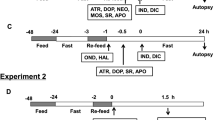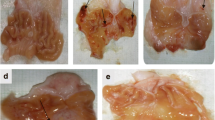Abstract
The effects of subcutaneous loperamide ongastric lesions induced by necrotizing agents wereinvestigated in the rat. Loperamide produced adose-dependent increase of gastric fluid volume andinhibition of gastric lesions caused by 0.6 N HCl orabsolute ethanol. Pretreatment with naloxone almostcompletely blocked both fluid pooling effect and mucosalprotective effect of loperamide. Omeprazole reduced the acidity of the gastric fluid in ratstreated with loperamide without significantly decreasingthe fluid volume. Various volumes of acid, given orallyimmediately before 0.6 N HCl, volume-dependently prevented gastric lesions. We conclude thatsubcutaneous loperamide protects the gastric mucosaagainst necrotizing agents through luminal dilution ofirritants, which is mediated by naloxonesensitive opiate receptors.
Similar content being viewed by others
REFERENCES
Hatakeyama Y, Matsuo M, Tomoi M, Ohtsuka M, Shimomura K: Luminal dilution caused by certain mild irritants and capsaicin contributes to their gastric mucosal protection. Am J Physiol 268:G200–G206, 1995
Barreto JC, Smith GS, Tornwall MS, Miller TA: Protective action of oral N-acetylcysteine against gastric injury: role of hypertonic sodium. Am J Physiol 264:G422–G426, 1993
Fallone CA, Morris GP: Topical nicotine protects rat gastric mucosa against ASA-induced damage. A role for mucosal fluid secretion in cytoprotection. Dig Dis Sci 40:936–942, 1995
Gutierrez-Cabano CA: Intragastric polyethylene glycol-400 protects against ethanol-induced gastric mucosal lesions despite pretreatment with indomethacin or iodoacetamide. Dig Dis Sci 40:2029–2036, 1995
Sørbye H, Guttu K, Gislason H, Grong K, Svanes K: Gastric mucosal injury and associated changes in mucosal blood flow and gastric fluid secretion caused by dimethyl sulfoxide (DMSO) in rats. Dig Dis Sci 38:1243–1250, 1993
Takeuchi K, Okada M, Niida H, Okabe S: Dual effects of N-ethylmaleimide on ethanol-induced gastric lesions in rats. Dig Dis Sci 36:870–879, 1991
Bunce KT: The effect of prostaglandins on gastric parietal and non-parietal secretion in the anaesthetized rat. J Pharm Pharmacol 39:825–831, 1987
Gana TJ, Macpherson BR, Ng D, Koo J: Ionic fluxes induced by topical misoprostol in canine gastric mucosa. Can J Physiol Pharmacol 67:353–358, 1989
Beubler E, Juan H: The function of prostaglandins in transmucosal water movement and blood flow in the rat jejunum. Naunyn-Schmiedeberg's Arch Pharmacol 299:89–94, 1977
Matuchansky C, Bernier JJ: Effect of prostaglandin E1 on glucose, water, and electrolyte absorption in the human jejunum. Gastroenterology 64:1111–1118, 1973
Pierce NF, Carpenter CCJ, Elliott HL, Greenough WB: Effects of prostaglandins, theophylline, and cholera exotoxin upon transmucosal water and electrolyte movement in the canine jejunum. Gastroenterology 60:22–32, 1971
Grotmol T, Van Dyke RW: Prostaglandin-and theophylline-induced Cl secretion in rat distal colon is inhibited by microtubule inhibitors. Dig Dis Sci 37:1709–1717, 1992
Galambos JT, Hersh T, Schroder S, Wenger J: Loperamide: A new antidiarrheal agent in the treatment of chronic diarrhea. Gastroenterology 70:1026–1029, 1976
Pelemans W, Vantrappen G: A double blind crossover comparison of loperamide with diphenoxylate in the symptomatic treatment of chronic diarrhea. Gastroenterology 70:1030–1034, 1976
Piercey MF, Ruwart MJ: Naloxone inhibits the anti-diarrhoeal activity of loperamide. Br J Pharmacol 66:373–375, 1979
Hughes S, Higgs NB, Turnberg LA: Loperamide has antisecretory activity in the human jejunum in vivo. Gut 25:931–935, 1984
Arakawa T, Satoh H, Nakamura A, Nebiki H, Fukuda T, Sakuma H, Nakamura H, Ishikawa M, Seiki M, Kobayashi K: Effects of zinc L-carnosine on gastric mucosal and cell damage caused by ethanol in rats. Dig Dis Sci 35:559–566, 1990
Bhounsule SA, Diniz D'Souza RS, Dhume VG: Gastric cytoprotective effect of morphine is probably not mediated by μ-receptors. Arch int Pharmacodyn 328:99–105, 1994
Gaginella TS, Bertko RJ, Kachur JF: Effect of dextromethorphan and levomethorphan on gastric emptying and intestinal transit in the rat. J Pharmacol Exp Ther 240:388–391, 1987
Flemström G, Jedstedt G, Nylander O: Effects of some opiates and vasoactive intestinal peptide (VIP) on duodenal surface epithelial bicarbonate secretion in the rat. Scand J Gastroenterol 20(suppl 110):49–53, 1985
Rights and permissions
About this article
Cite this article
Hatakeyama, Y., Tomoi, M.M., Ohtsuka, P.M. et al. Subcutaneous Loperamide Prevents Gastric Lesions Induced by Necrotizing Agents in Rats. Dig Dis Sci 42, 2560–2565 (1997). https://doi.org/10.1023/A:1018876915337
Issue Date:
DOI: https://doi.org/10.1023/A:1018876915337




